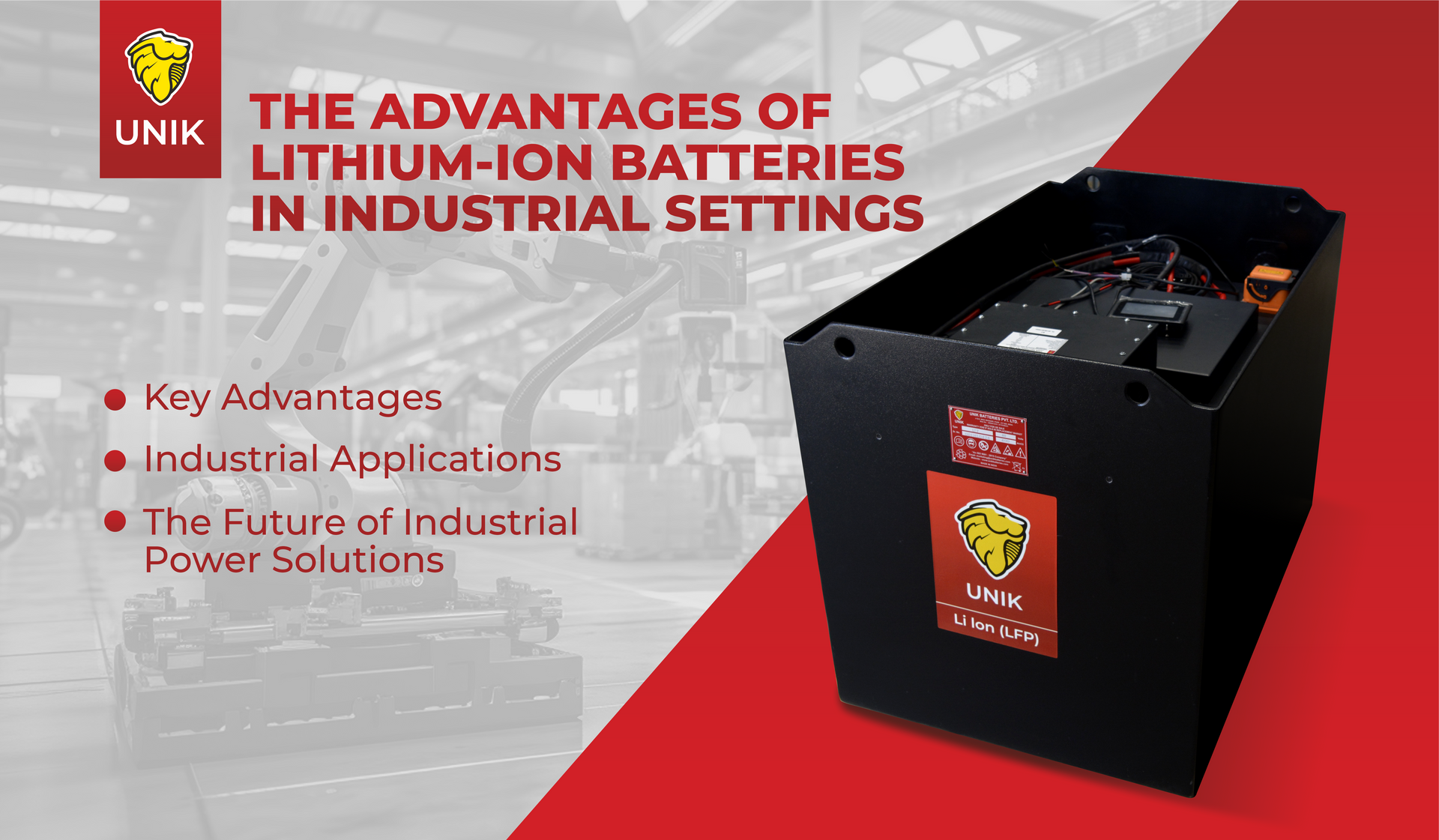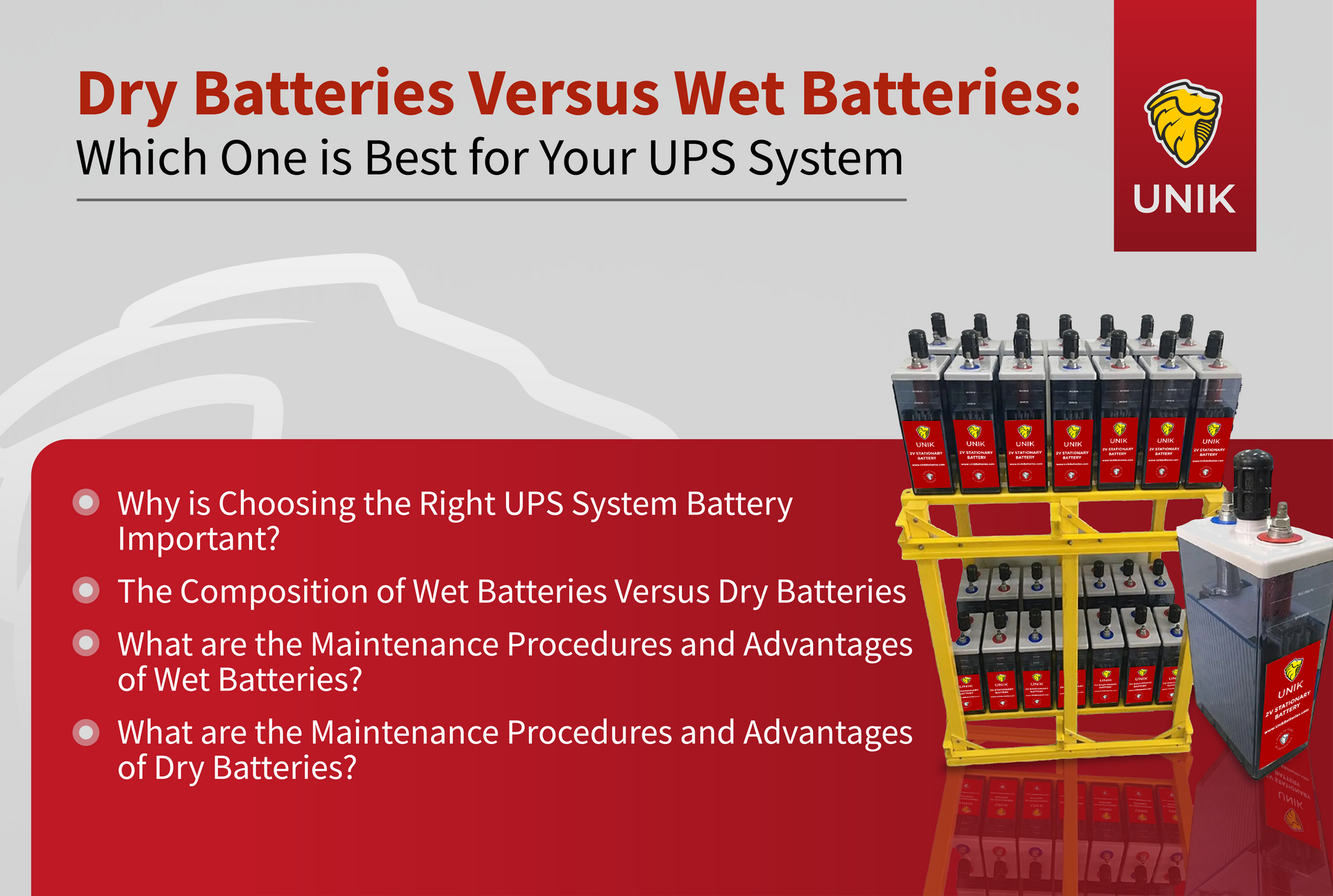KNOWLEDGE CENTRE
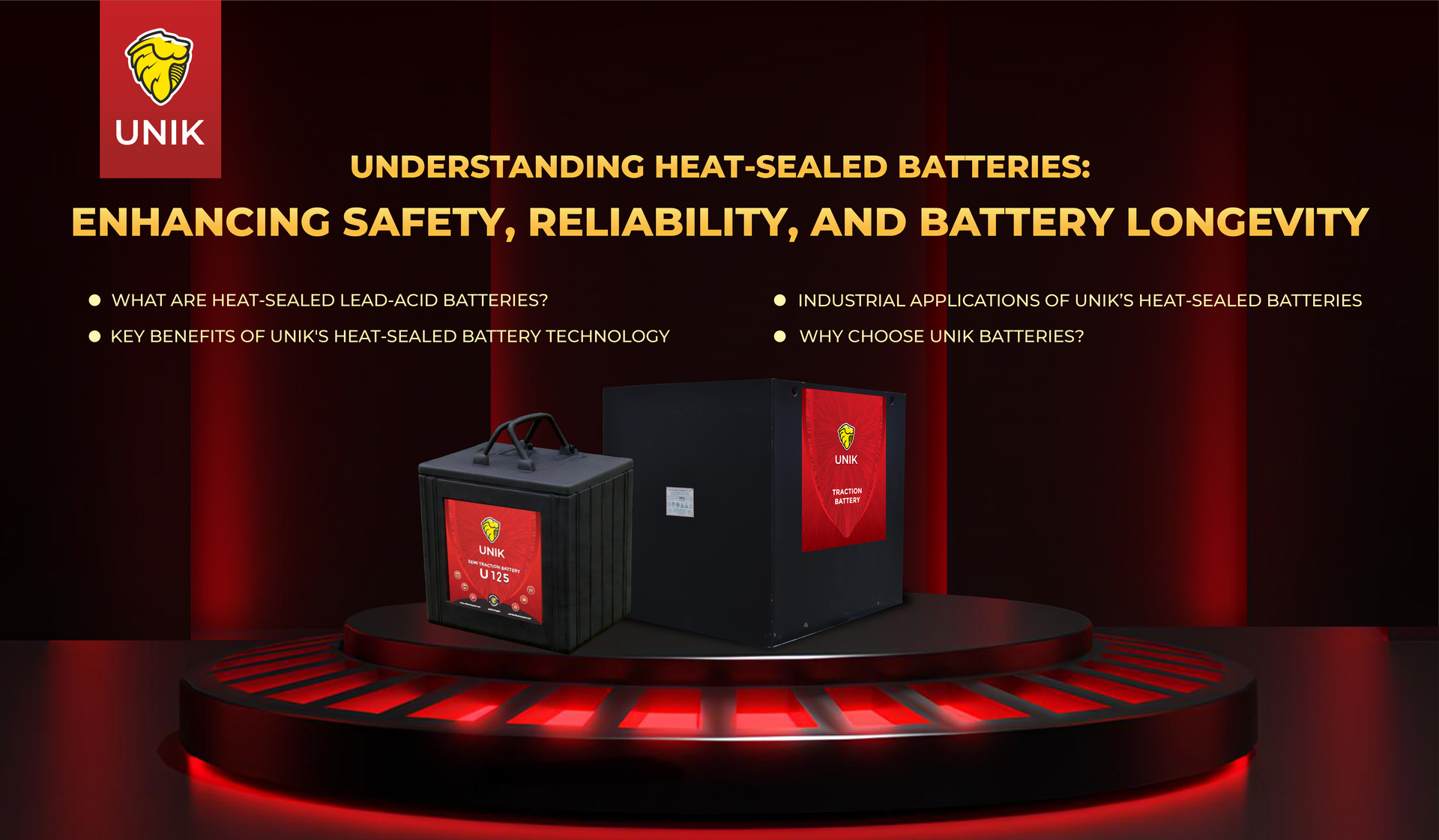
By Unik Techno
•
March 28, 2025
Battery safety is critical in industries relying heavily on robust, dependable power sources such as electric forklifts, golf carts, and industrial machinery. One technology significantly advancing battery safety is heat-sealed battery construction . At UNIK Batteries, we utilise advanced heat-sealing techniques to provide superior safety, reliability, and longer battery life for demanding industrial applications. What Are Heat-Sealed Lead-Acid Batteries? Heat-sealed lead-acid batteries are constructed using a specialised sealing process where battery casings are permanently bonded through heat application. Unlike traditional battery sealing methods using adhesives or mechanical seals, heat sealing creates a highly durable, airtight enclosure, ideal for demanding industrial environments. Key Benefits of UNIK's Heat-Sealed Battery Technology Electrolyte Leakage Prevention Higher resistance levels, which may impact power output. Reduced charging efficiency, resulting in longer charge times. Increased operational strain, potentially leading to faster wear and tear. Here is why winter battery maintenance is essential: Proper care reduces the risk of cell damage due to freezing temperatures. Batteries that are well-maintained offer operational efficiency. Regular maintenance extends the life of your batteries, saving on replacement costs. Taking these steps will keep your i ndustrial forklift battery in peak condition, even when temperatures plummet. Lead Acid & Lithium-ion Battery Care in Cold Weather Maintenance of Lead Acid Batteries Lead acid batteries are more sensitive to cold temperatures because their electrolyte solution can freeze, particularly when the battery is in a low-charge state. For efficient battery care in cold weather, follow these tips: Charge fully after each use as a fully charged lead-acid battery is less likely to freeze. Store batteries in a temperature-controlled environment indoors or in a heated area to protect them from the elements. Inspect the battery for cracks or leaks, as these can worsen in the cold. Lead-acid batteries need adequate water to function correctly, so check and refill water levels routinely. Clean terminals regularly to prevent corrosion and improve conductivity. Lithium-ion Battery Maintenance While lithium-ion batteries fare better than lead acid batteries in colder weather, they still require care to avoid performance drops. Follow these tips for top-notch lithium-ion battery maintenance: When starting your material handling equipment, give your battery some time to warm up just as you would allow your car battery to reach an optimum temperature before driving. Lithium-ion batteries should not be charged at sub-zero temperatures, as this can lead to permanent damage. Lithium-ion batteries are more efficient when they maintain a moderate charge level in winter between 30-80%, to reduce strain on the cells. Following these steps can help ensure that both l ead acid and lithium-ion battery maintenance routines are winter-ready. Winter can be challenging for industrial forklift batteries , but with consistent battery care in cold weather , you can protect your investment and keep your operations running smoothly. By paying attention to winter battery maintenance and adjusting your care strategies for different battery types, you can enhance battery performance and extend its life, no matter how cold it gets. Protect your operations all season long! For more tailored solutions, explore our lithium-ion battery and lead acid battery sections to find the best fit for your material handling operations. Contact us today to learn how our battery solutions can power your success.

By Unik Techno
•
January 31, 2025
When it comes to powering industrial equipment, the choice of battery plays a crucial role in ensuring efficiency and reliability. Traction and semi-traction batteries are key players in this arena, each designed to meet specific operational needs. This blog delves into what these batteries are and their applications in industrial settings. What are Traction Batteries? Traction batteries are specialised rechargeable batteries used to power heavy-duty industrial equipment. Unlike traditional starter batteries, they are engineered to provide reliable and consistent power over extended periods, making them suitable for applications that require deep discharges and frequent recharging. These batteries are typically made up of several cells connected in series, with the most common types being lead-acid traction batteries and lithium-ion . Lead-acid traction batteries are favored for their cost-effectiveness and durability, whereas lithium-ion traction batteries are sought after for their high energy density and lower maintenance requirements. What are the Applications of Traction Batteries? Traction batteries are widely used for rigorous applications in sectors, such as golf carts, renewable energy systems, medical equipment, and power backup systems. Material handling and industrial applications benefit significantly from these batteries. Traction batteries for material handling equipment are used for powering forklifts, pallet jacks, and other material-handling equipment. The high capacity and durability of lead-acid traction batteries and lithium-ion traction batteries make them perfect for these tasks. They ensure reliable performance and longevity in demanding environments, including warehouses and factories that rely on robust power supply. What are Semi-traction Batteries? Semi-traction batteries, also known as monobloc batteries, are engineered for exceptional performance in industrial settings where consistent power is required over extended periods. These batteries are specifically designed to handle repetitive and intense cycle use. A semi-traction battery is constructed with multiple electrically connected cell compartments containing electrodes, electrolytes, terminals, and separators. These cells can be arranged in series or parallel configurations to tailor the battery's performance to specific applications. Semi-traction batteries are engineered to endure harsh conditions, including wide temperature fluctuations (-30°C to 60°C) and exposure to shocks and vibrations. What are the Applications of Semi-traction Batteries? Semi-traction batteries are versatile and provide dependable power for various applications where the energy demand is moderate and consistent, but not as intensive as in heavy industrial use. These batteries are particularly effective in settings where a reliable energy source is needed over an extended period. They may be used for less intensive off-grid solar power systems and energy storage applications. Semi-traction batteries are particularly advantageous in golf carts and industrial cleaning equipment . Golf carts benefit from the battery’s ability to endure frequent discharge cycles, vibrations, and temperature variations, providing reliable power in varied conditions. Similarly, semi-traction batteries excel in industrial cleaning equipment, such as floor scrubbers, where they provide the necessary power to operate efficiently over long periods, withstanding the rough conditions typical in industrial environments. In the world of industrial equipment, the choice between traction and semi-traction batteries can significantly impact operational efficiency and longevity. Traction batteries provide robust, reliable power for heavy-duty applications, such as material handling equipment, while semi-traction batteries offer a dependable solution for moderate energy needs, like those found in golf carts and cleaning machines. By selecting the right type of battery for each specific application, businesses can ensure uninterrupted operations, reduce downtime, and maintain consistent performance in all conditions. UNIK recognises the diverse battery needs of different industries and is here to help you find the perfect fit. Contact us today to learn how our battery solutions can power your success.
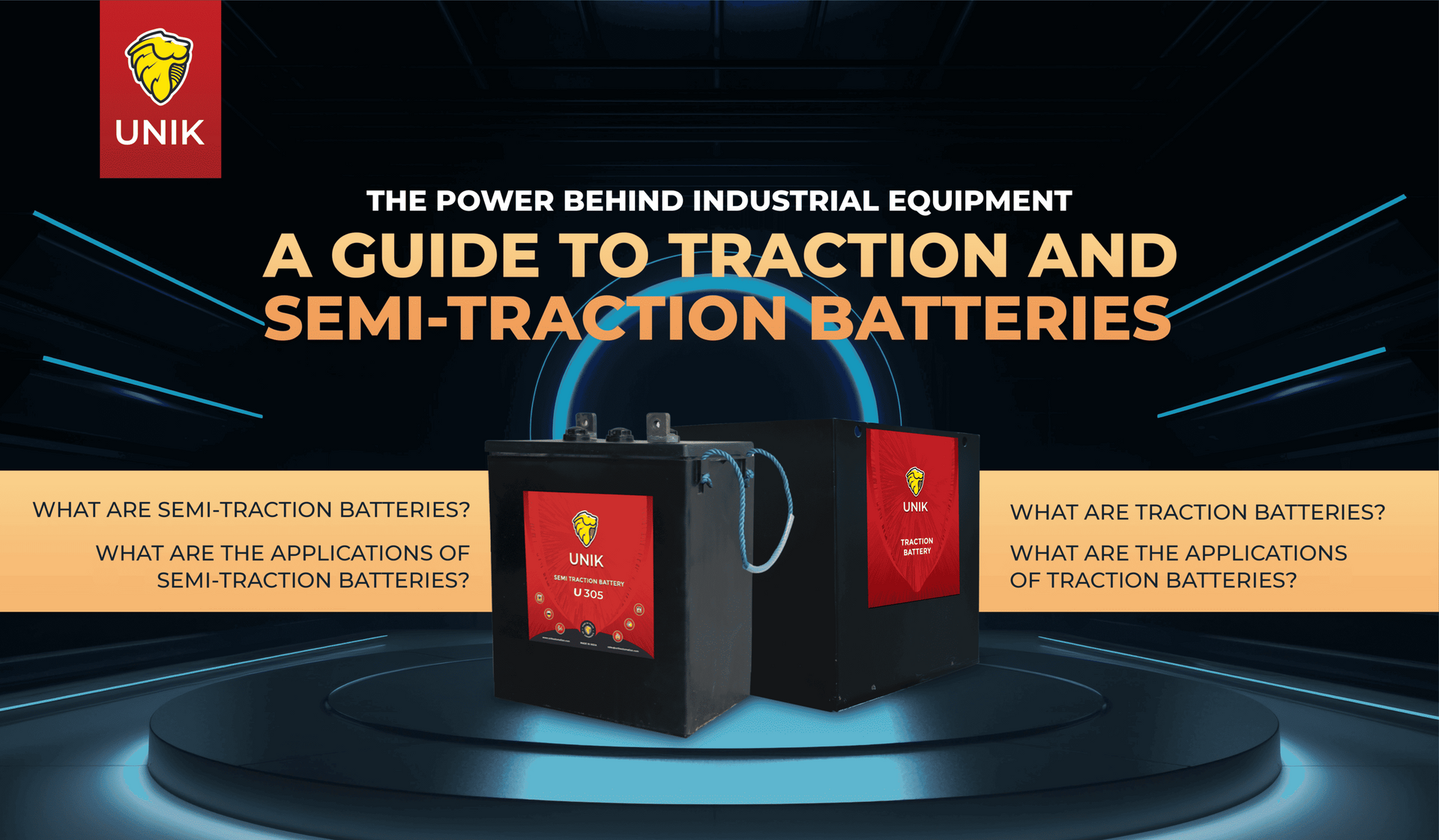
By Unik Techno
•
December 26, 2024
When it comes to powering industrial equipment, the choice of battery plays a crucial role in ensuring efficiency and reliability. Traction and semi-traction batteries are key players in this arena, each designed to meet specific operational needs. This blog delves into what these batteries are and their applications in industrial settings. What are Traction Batteries? Traction batteries are specialised rechargeable batteries used to power heavy-duty industrial equipment. Unlike traditional starter batteries, they are engineered to provide reliable and consistent power over extended periods, making them suitable for applications that require deep discharges and frequent recharging. These batteries are typically made up of several cells connected in series, with the most common types being lead-acid traction batteries and lithium-ion . Lead-acid traction batteries are favored for their cost-effectiveness and durability, whereas lithium-ion traction batteries are sought after for their high energy density and lower maintenance requirements. What are the Applications of Traction Batteries? Traction batteries are widely used for rigorous applications in sectors, such as golf carts, renewable energy systems, medical equipment, and power backup systems. Material handling and industrial applications benefit significantly from these batteries. Traction batteries for material handling equipment are used for powering forklifts, pallet jacks, and other material-handling equipment. The high capacity and durability of lead-acid traction batteries and lithium-ion traction batteries make them perfect for these tasks. They ensure reliable performance and longevity in demanding environments, including warehouses and factories that rely on robust power supply. What are Semi-traction Batteries? Semi-traction batteries, also known as monobloc batteries, are engineered for exceptional performance in industrial settings where consistent power is required over extended periods. These batteries are specifically designed to handle repetitive and intense cycle use. A semi-traction battery is constructed with multiple electrically connected cell compartments containing electrodes, electrolytes, terminals, and separators. These cells can be arranged in series or parallel configurations to tailor the battery's performance to specific applications. Semi-traction batteries are engineered to endure harsh conditions, including wide temperature fluctuations (-30°C to 60°C) and exposure to shocks and vibrations. What are the Applications of Semi-traction Batteries? Semi-traction batteries are versatile and provide dependable power for various applications where the energy demand is moderate and consistent, but not as intensive as in heavy industrial use. These batteries are particularly effective in settings where a reliable energy source is needed over an extended period. They may be used for less intensive off-grid solar power systems and energy storage applications. Semi-traction batteries are particularly advantageous in golf carts and industrial cleaning equipment . Golf carts benefit from the battery’s ability to endure frequent discharge cycles, vibrations, and temperature variations, providing reliable power in varied conditions. Similarly, semi-traction batteries excel in industrial cleaning equipment, such as floor scrubbers, where they provide the necessary power to operate efficiently over long periods, withstanding the rough conditions typical in industrial environments. In the world of industrial equipment, the choice between traction and semi-traction batteries can significantly impact operational efficiency and longevity. Traction batteries provide robust, reliable power for heavy-duty applications, such as material handling equipment, while semi-traction batteries offer a dependable solution for moderate energy needs, like those found in golf carts and cleaning machines. By selecting the right type of battery for each specific application, businesses can ensure uninterrupted operations, reduce downtime, and maintain consistent performance in all conditions. UNIK recognises the diverse battery needs of different industries and is here to help you find the perfect fit. Contact us today to learn how our battery solutions can power your success.
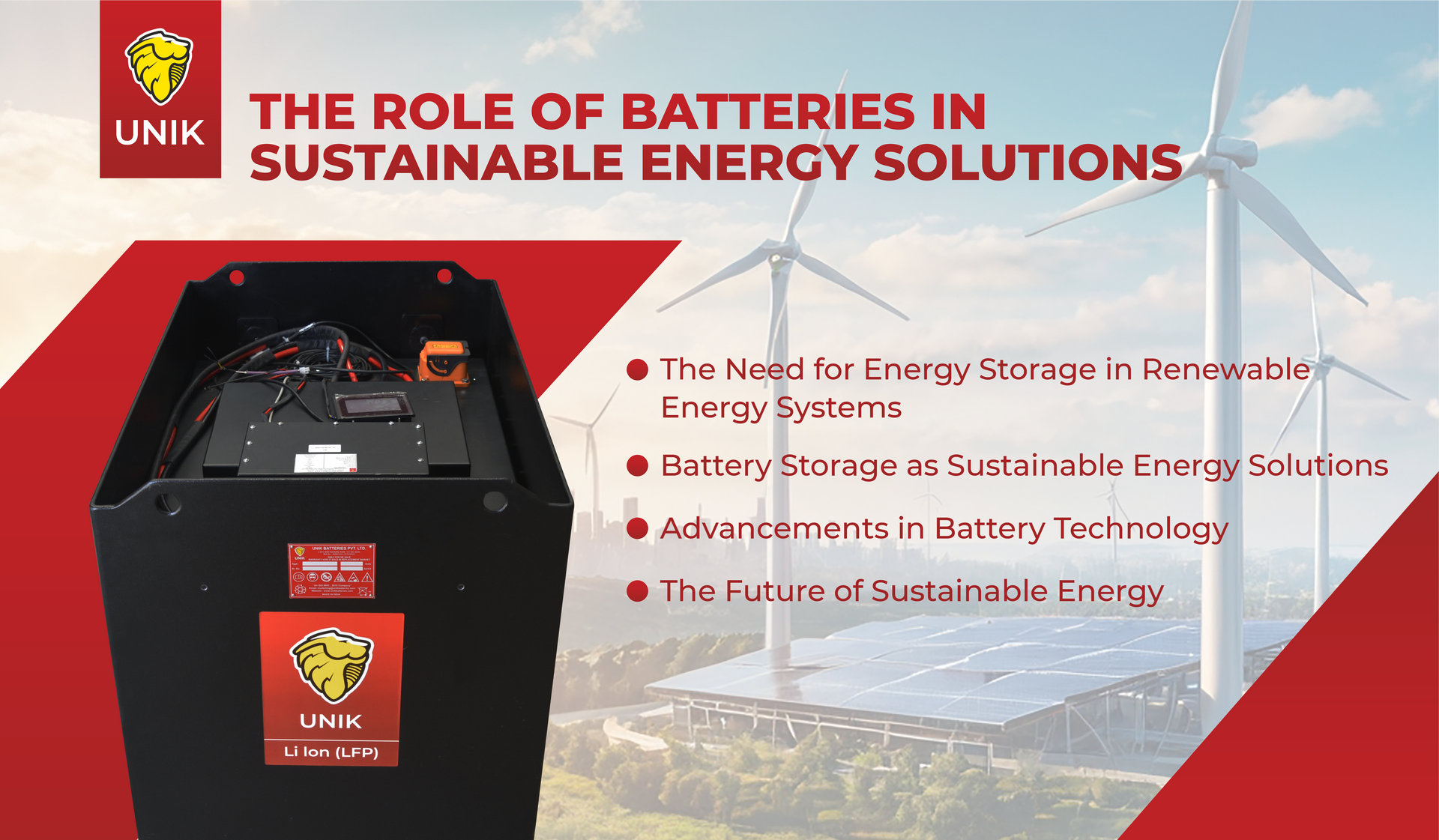
By Unik Techno
•
August 29, 2024
As the world moves towards a future powered by renewable energy sources, the importance of energy storage systems, particularly batteries, has become increasingly apparent. Batteries play a crucial role in sustainable energy solutions by enhancing energy efficiency, stabilising the grid, and enabling the widespread adoption of renewable energy. This article explores the integral role of batteries in sustainable energy systems and how advancements in battery technology are driving the transition to a greener future. The Need for Energy Storage in Renewable Energy Systems Renewable energy sources like solar and wind power are inherently variable. Solar power is only generated during daylight hours, and wind energy depends on weather conditions. This variability poses a significant challenge to maintaining a consistent and reliable energy supply. Traditional energy grids, designed for steady power generation from fossil fuels, need help integrating these intermittent renewable energy sources. Energy storage systems, particularly batteries, are essential for overcoming this challenge. By storing excess energy generated during peak production periods, batteries ensure that energy is available when renewable energy sources are not generating power. This capability stabilizes the grid and maximizes the use of renewable energy, reducing reliance on fossil fuels. Battery Storage: A Cornerstone of Sustainable Energy Solutions Battery storage systems are a cornerstone of sustainable energy solutions. They provide several key benefits that support the transition to a more sustainable energy landscape: Grid Stability and Energy Efficiency: Batteries stabilize the grid by balancing supply and demand, preventing blackouts, and improving energy efficiency by storing excess energy for later use. Integration of Renewables Batteries enable the smooth integration of renewable energy sources into the grid, allowing for higher renewable penetration without compromising reliability. Decentralized Energy Solutions: Batteries support decentralized energy systems like microgrids, offering flexibility and reliability, especially in remote or underserved areas. Advancements in Battery Technology The effectiveness of battery storage systems in sustainable energy solutions largely hinges on the underlying technology. Lead-acid batteries have long been the tried and tested technology, but lithium-ion batteries are increasingly becoming the most widely used type in energy storage systems. Recent advancements in lithium-ion technology have significantly improved their energy density, lifespan, and safety, making them more suitable for large-scale applications. They offer a high energy density, allowing for more energy storage in a smaller space, which benefits both residential and commercial energy systems. Ongoing research enhances their performance and sustainability, including developing recycling processes to mitigate environmental impact. Beyond lithium-ion, researchers are exploring next-generation battery technologies, such as solid-state and flow batteries. These promising innovations offer even greater storage capacity, faster charging times, and longer lifespans, which could further boost the adoption of renewable energy. The Future of Sustainable Energy with Battery Storage The future of sustainable energy is inextricably linked to the development and deployment of advanced battery storage systems. As renewable energy sources grow, the demand for efficient, reliable, and scalable energy storage solutions will increase. Batteries will be pivotal in this transition, enabling a more resilient and sustainable energy grid. Governments and businesses worldwide recognize battery storage's importance in achieving their sustainability goals. Investments in battery technology are growing, and innovative projects are being launched to demonstrate the potential of batteries in real-world applications. Conclusion Batteries are more than just a component of sustainable energy systems—they are the linchpin that holds them together. By providing the necessary storage and flexibility, batteries enable the effective integration of renewable energy sources, enhance energy efficiency, and contribute to grid stability. As technology advances, batteries' role in sustainable energy solutions will become even more critical, paving the way for a cleaner, more sustainable future. By embracing battery storage as a key element of the energy transition, we can unlock renewable energy's full potential and move closer to a world powered by sustainable energy solutions.

By Unik Techno
•
May 23, 2024
Golf cart batteries are the heart of your golf cart, providing the necessary power to drive smoothly across the greens. Understanding the different types of batteries, their maintenance and the factors affecting their lifespan can help you make an informed decision and ensure your cart runs efficiently. Types of Golf Cart Batteries There are three main types of golf cart batteries: Lead Acid Batteries : The most common and economical option, lead acid batteries have been used in golf carts for decades. They require regular maintenance, including checking water levels and cleaning terminals. AGM Batteries : Absorbent Glass Mat (AGM) batteries are a type of valve-regulated lead acid battery (VRLA). They are sealed, require less maintenance, and are less prone to leakage. AGM batteries are a bit more expensive but offer longer life and better performance. Lithium-Ion Batteries : The newest and most advanced option, lithium-ion batteries are durable, lightweight and require minimal maintenance. They are also more expensive but provide the best performance and efficiency. Maintenance Tips for Golf Cart Batteries Proper maintenance is crucial to extend the life of your golf cart batteries. Here are some essential tips: Regular Charging : Always keep your batteries fully charged. Avoid deep discharges as they can shorten the battery’s lifespan. Charge the batteries after every use, and if the cart is not in use, recharge them every few weeks. Water Levels : For lead acid batteries, check the water levels regularly and top them off with distilled water. Never overfill, as it can lead to spillage and corrosion. Clean Terminals : Keep the battery terminals clean and free of corrosion. Use a mixture of baking soda and water to clean them, and apply a terminal protector spray to prevent future corrosion. Proper Storage : If storing your golf cart for an extended period, ensure the batteries are fully charged and disconnect them to prevent discharge. Store the batteries in a cool, dry place. Factors Affecting Battery Life Several factors can influence the lifespan of your golf cart batteries: Usage : Overusing the battery without rest and opportunity charging can impact the lifespan of the battery. Temperature : High temperatures can lead to overheating, while low temperatures can reduce battery capacity. Maintenance : Proper and regular maintenance can significantly extend the life of your batteries. Neglecting maintenance can lead to premature failure. Conclusion Choosing the right golf cart battery and maintaining it properly is essential for optimal performance and longevity. Whether you opt for lead acid, AGM, or lithium-ion batteries, understanding their needs and how to care for them will ensure your golf cart remains reliable and efficient. At UNIK Batteries, we offer a range of high-quality batteries to meet all your golf cart needs, ensuring you get the best performance on the greens. Contact us and explore how our batteries can help you achieve long-term energy sustainability goals.

CORPORATE OFFICE:
UNIK Batteries Pvt. Ltd.
J-52/4, Indrayaninagar Road, M.I.D.C, Bhosari, Pune, Maharashtra
411 026, India.
CONTACT US:
International enquiries:
Meghav Bafana
Phone: +44 7756 077320
Email:
meghav@unikbatteries.com
Local & general enquiries:
Shubhangi Daundkar
Phone: +91 98504 13331
Email:
marketing@unikbatteries.com
© 2025 Unik Batteries Pvt. Ltd. All Rights Reserved
Digital Presence Managed By: Knowledge Units


